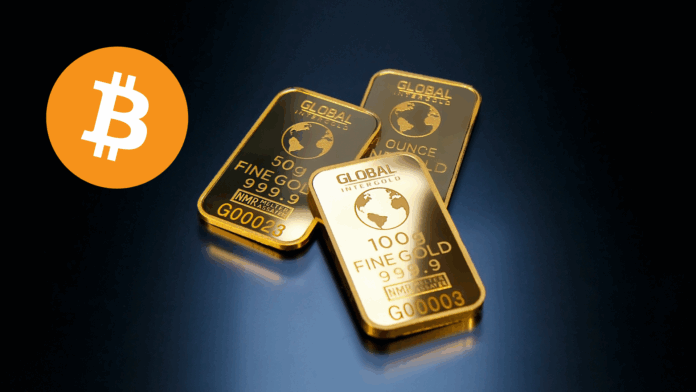In a significant market shift that has caught the attention of investors worldwide, gold has experienced a notable correction from its recent record highs while Bitcoin has simultaneously rallied. This inverse relationship between the two assets is raising questions about changing investor preferences and highlighting Bitcoin’s emerging role as an alternative hedge against economic uncertainty.
Gold’s Sharp Correction After Record Highs
Gold prices have dropped sharply as risk appetite returned to markets. After reaching an unprecedented peak above $3,500 per ounce on April 21, the precious metal has tumbled nearly 10%, stabilizing around the $3,200 level. This correction comes after a remarkable rally that was largely fueled by President Trump’s “Liberation Day” tariffs announced in early April, which initially drove investors toward safe-haven assets.
According to recent market data, gold fell over $70 on Thursday alone, hitting a low of $3,202. The correction appears to be tied to several factors, including:
- Improved risk sentiment as President Trump exempted some auto tariffs and advanced trade talks with key partners
- A strengthening U.S. dollar as trade tensions with China and other countries eased
- Rising Treasury yields, with the 10-year yield climbing to 4.23%, increasing the opportunity cost of holding non-yielding assets like gold
Technical analysis indicates that gold is now approaching important support levels. The daily chart shows a correction from the strong resistance at $3,500, with the price moving toward support zones at $3,200-$3,150, marked by the upper boundary of an ascending channel pattern.
Also Read: Bitcoin Just Hit Its Highest Price in 60 Days. 3 Reasons Behind the Rally.
Bitcoin’s Concurrent Rally
While gold has been correcting, Bitcoin has charted an impressive upward trajectory. The cryptocurrency has rallied approximately 10% since gold’s peak, reaching a two-month high of $97,000. This represents a significant recovery for Bitcoin, which had been down about 20% from its January record high when gold was peaking.
The timing of this inverse movement has not gone unnoticed by market analysts. Standard Chartered’s Geoff Kendrick observed, “I think bitcoin is a better hedge than gold against strategic asset reallocation out of the U.S.” This statement reflects growing sentiment that Bitcoin may be emerging as a more responsive hedge against certain types of market uncertainties.
The ETF Flow Reversal
Perhaps the most telling indicator of this shifting dynamic between gold and Bitcoin is the reversal in exchange-traded fund (ETF) flows. Money has been flowing out of gold ETFs and into Bitcoin funds at an accelerating pace.
Kendrick noted that the ETF inflow situation has completely flipped along with the price movements. The last time Bitcoin ETF inflows had such a wide margin over gold was during the week of the U.S. presidential election. Following that period, Bitcoin’s price rose more than 40% in two months, eventually surpassing $100,000.
This pattern suggests that institutional investors may be reevaluating their positions on digital assets versus traditional safe havens like gold, particularly in response to specific economic and political developments.
Market Implications and Future Outlook
The current inverse relationship between gold and Bitcoin raises important questions about their respective roles in investment portfolios. While gold has traditionally been the go-to safe-haven asset during times of economic uncertainty, Bitcoin’s recent performance during the gold correction indicates it may be carving out its own niche as a hedge against different types of market risks.
Several factors could influence the continuation of this trend:
- U.S. Economic Data: The market awaits the NFP (Non-Farm Payrolls) data, which could provide further guidance on both gold and Bitcoin prices. Weak labor reports would likely put pressure on the dollar and could boost both assets, potentially altering their current inverse relationship.
- Monetary Policy Expectations: Any signals about potential interest rate cuts from the Federal Reserve would significantly impact both assets, though possibly in different ways.
- Global Trade Dynamics: The evolution of tariff policies and international trade relationships will continue to influence safe-haven demand and risk appetite in markets.
For investors, this evolving relationship between gold and Bitcoin suggests that the two assets might increasingly serve complementary rather than competitive roles in portfolio diversification strategies. While gold maintains its historical significance and relative stability, Bitcoin appears to be responding differently to certain market conditions, potentially offering an alternative hedging mechanism against specific economic scenarios.
As markets navigate through uncertain economic waters, the relationship between these two prominent store-of-value assets will remain a critical indicator of investor sentiment and risk perception in the global financial landscape.
Want real-time updates on Bitcoin, Ethereum, and blockchain trends? Crypto News Today delivers breaking crypto news, expert insights, and price movements to keep you informed.




